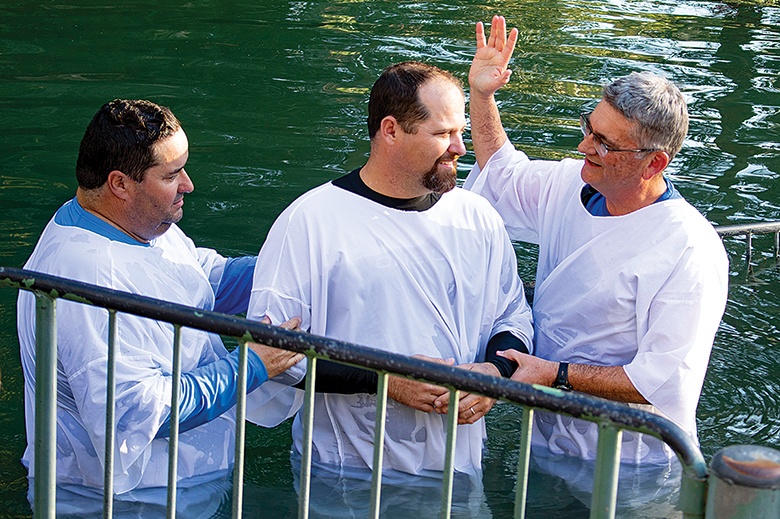Leadership
- REIMAGINING MINISTRY: Serving Gen Z with innovation and purpose
By Denise Craig, CAE, CCA The Church has always been a place of transformation, where people are changed and challenged spiritually and relationally. Today, we find ourselves in a season of transformation once again, not only in how we minister but in how we manage the ministries entrusted to us. Barna recently published research showing that Gen Z is attending church more than any other generation, so we must consider how that will that affect the way we do ministry, especially as AI continues to quickly change the digital landscape. The Rise of AI in Church Operations AI is no longer a futuristic concept — it’s a present-day tool that can help churches operate more efficiently and serve more effectively. From automating routine tasks to analyzing complex data, AI can support ministry in ways that free up time and energy for what matters most: people. Consider these practical applications: Smart Scheduling: AI can coordinate calendars, volunteer shifts, and event logistics with minimal manual input. Chatbots and Virtual Assistants: These tools can answer common questions on your website, guide new visitors, and even help with event sign-ups. Data Analytics: AI can identify giving trends, attendance patterns, and engagement shifts — helping leaders make informed decisions. Personalized Communication: AI can tailor messages based on individual interests and behaviors, ensuring that people receive relevant, timely information. These tools don’t replace the human touch; they enhance it. They allow us to focus more on relationships and less on repetitive tasks. Rethinking Metrics: Beyond Attendance and Giving As we integrate new tools, we must also re-evaluate what we measure. For decades, church success was often defined by three numbers: attendance, giving, and membership. While these remain important, they no longer tell the full story, especially in a world where digital engagement, community impact, and spiritual formation are just as vital. Gen Z, now attending church more frequently than any other generation, is leading the charge in redefining what it means to be part of a faith community. They may not attend every Sunday, but they engage deeply through worship, service projects, and small groups. They value authenticity, purpose, and participation over programs and polish. This means we must expand our metrics to include: Digital Engagement: Tracking livestream views, podcast downloads, and social media interactions. Spiritual Growth: Monitoring participation in discipleship pathways, small groups, and spiritual practices. Community Impact: Measuring volunteer hours, outreach initiatives, and partnerships with local organizations. Relational Connection: Understanding how people are forming meaningful relationships within the church. Administrative Shifts for a New Generation Gen Z’s presence is also influencing how we structure and lead our churches. They value transparency, collaboration, and purpose-driven leadership. As a result, church administration is evolving in several ways: Digital-First Systems: From mobile-friendly giving platforms to app-based communication, churches must invest in tools that meet people where they are. Leadership Development: Gen Z wants to contribute, not just consume. Administrators must create clear pathways for young adults to lead, serve, and grow. Policy Updates: As ministry models change, so must our policies — especially around digital privacy, volunteer care, and hybrid ministry practices. Flexible Staffing and Wellness: With a growing emphasis on mental health and work-life balance, churches are rethinking how they support staff and volunteers. These aren’t just operational changes. They are cultural shifts that reflect a deeper commitment to serving people well. Moving Forward with Faith and Wisdom As we navigate this new terrain, it’s essential to approach both AI and evolving metrics with discernment. We must ask: Does this tool help us love and serve people better? Does this data reflect our mission and values? Are we using technology to enhance, not replace, human connection? At The Church Network, we believe that church administration is a sacred calling. It’s about creating systems that support ministry, foster community, and steward resources with excellence. By embracing innovation and rethinking success, we can build churches that are not only efficient but also deeply impactful. Let’s lead with open hands, open minds, and open hearts — ready to serve a new generation with timeless truth and timely tools. Related URLS: To explore the resources of The Church Network, visit: https://thechurchnetwork.com Denise Craig, CAE CCA is a dynamic leader with more than 30 years of experience, currently serving as the CEO of The Church Network. She is passionate about helping others discover their God-given purpose and excels in strategic leadership. Denise is a member of the advisory panel for Church Executive Magazine, serves on the Board of Directors for the Tennessee Society of Association Executives, and is a frequent speaker at various events. She holds certifications as a Certified Association Executive, Certified Church Administrator, and Certified Financial Coach. Denise can be reached at denise@thechurchnetwork.com. *TCN reserves all rights to this article. We grant Church Executive an unlimited license to publish the article, post it on their website, and include it in an eBook.
Risk Management
- Stewardship Practices of Thriving Ministries
By Brian Lindquist The modern insurance landscape is much different than it was even five years ago. Record losses, inflation, high construction costs, and more have all contributed to rising insurance costs. This industry-wide trend has many ministries asking questions about how to maximize the value of their insurance. There are many factors that drive the overall cost of insurance, and losses play a main role. Generally, more losses lead to a higher cost of insurance for everyone. Several insurance insiders from Brotherhood Mutual share their insights on how to manage risk and get the most from your insurance. They’ve intensely studied what successful ministries do to protect themselves. “Insurance is intended to be protection for a large financial loss that an organization couldn’t otherwise survive,” said Joel Colglazier, assistant vice president of underwriting at Brotherhood Mutual. In other words, it’s designed to make you whole again after loss. TOP TIPS FOR MAXIMIZING THE VALUE OF YOUR INSURANCE Controlling Cost To understand how you can control the cost of your insurance policy, you need to understand how your insurance policy is rated. Insurance companies look at your campus and facilities, and your geographic location to determine the types of losses that are more likely for your area, such as fire, coastal storms, hail, and others. They’ll also look at the types of losses that are probable for the types of activities you’re engaged in. Finally, insurance companies will look at how your past losses might help to predict your future losses. When it’s time to renew your policy, or if you switch insurance companies, one of the things they look at is how many times a ministry has submitted a claim. Frequently submitting claims, even when they seem small, adds up. And frequent claims can increase the cost of your insurance because you’re at greater risk of having a larger claim in the future. This is where the concept of risk management comes into play. “Insurance is one piece of a larger risk management puzzle,” noted Colglazier. In addition to having insurance, taking proactive steps to avoid claims altogether is an important step that helps ministries in the long run. “One of the most important risk management steps is to think of your insurance company and agent as a partnership,” said Colglazier. Collaboratively working together to strengthen your resiliency is central to Brotherhood Mutual’s mission of advancing the Kingdom by serving the Church. Insurance helps protect the future of your ministry’s people and property. While it’s crucial to have the right insurance, it’s also important to take proactive steps to reduce or prevent losses from happening altogether. Not only does this reduce the chance you’ll have out of pocket expenses, but it can help control the cost of your insurance. Managing Risk Managing risk helps ministries steward their resources and maximizes the value of insurance. “It’s a two-part process,” offered Andy Hayton, a regional manager with Brotherhood Mutual. “First, it involves looking at what you can do now to prevent claims from happening in the first place. Second, if you have had a claim, it’s looking at what you can do to prevent it from happening again.” For example, as you implement policies and procedures or if you add something to your property to improve safety, document that and let your agent know. “This is helpful, especially when you make improvements after a claim event,” said Hayton. Protecting Against Property Risk Property risks are those that affect your buildings, equipment, vehicles, and other assets. These include fire, water damage, theft, vandalism, wind, hail, lightning, and others. Property risks can result in costly repairs or replacements, as well as disruptions to your ministry activities. So it’s good to think ahead when it comes to managing risk on your property. “The bottom line is that ministries need to be proactive and control the controllable. Routinely walk around your campus to identify hazards before they become a problem. Make repairs quickly while they are small and more affordable,” noted Colglazier. “Ministries need to have a plan and budget for the things that can improve safety and resilience.” Managing Liability Risks Liability risks are those that affect your legal responsibility for the safety and well-being of others. These include injuries, accidents, lawsuits, allegations, and other claims that can arise from your ministry activities. Liability risks can result in costly settlements, judgments, medical bills, legal fees, and reputational damage. “I recommend that ministries keep good records,” said Ron Troyer, a senior manager in casualty claims for Brotherhood Mutual. This includes everything from financial decisions to board meeting minutes, volunteer position descriptions, and documenting slips, trips, and falls. Also, it’s important to follow your ministry’s written guidelines. If you don’t have guidelines, start developing them right away. And when the potential for a lawsuit arises, for example, someone threatens to sue, Troyer’s advice is to report it. “We’ll investigate and see if there are things that we can do to help you prevent an issue from becoming a lawsuit. If you try to handle it yourself and someone ends up suing you, it may become much more complicated.” The risk management tips on the following page are some of the most critical actions that healthy, successful ministries take when managing their risks and reducing or preventing loss. See how many of these steps your ministry currently has in place. Property Protection Tips Keep your building well maintained and updated. A well-kept building shows that you care about your ministry and your risk management. Make sure your fire sprinkler system is centrally monitored by a professional service. Keep up on annual and five-year inspections as well as maintenance of your sprinkler system. Install a flow-based automatic water shut-off device. This can prevent major water damage and mold growth, which are both some of the most costly and disruptive types of claims for ministries. Plus, it can potentially lower your deductible for freeze claims. Have your electrical panels inspected by a licensed electrician at least annually. Read More >
Pastor-Friendly A/V
- IN FULL-FLOW MODE: Steve Tignor + Wave Church
By RaeAnn Slaybaugh For years, the production team at Wave Church in Virginia Beach, Va., battled content storage inefficiencies. Multiple servers created chaos and disruption. A lack of remote access limited the content they could produce. Nickel-and-dime pricing for the features they needed created anxiety and uncertainty. Altogether, this made it tough for Production/Communications Director Steve Tignor and his staff to produce the high-quality content that was not just needed, but that they were passionate about creating. Then, a game-changing alternative emerged — one that saves them tens of thousands of dollars a year. One that’s much easier to use and highly accessible (even remotely). A solution that accommodates 400% more content and ramps up the speed of content production by at least 30%. It wasn’t too good to be true. Here’s how. Nearly 10 years ago, Wave Church made the jump to using a studio-quality storage area network, or SAN — basically, a large, expensive hard drive. “We had to have it,” recalls Production/Communications Director Steve Tignor. “For the things we were doing — producing a lot of content, and even a TV show — speed is everything.” To start, the team got to work ‘digitizing everything,’ according to Tignor. “We moved all our content off of DVDs and other forms of storage, like Dropbox,” he recalls. This included rooms full of videotapes dating back to 1999. In the end, they wound up with four workstations providing access to every file a team member might need … but they really had to work for it. A Virtual Private Network (VPN) was set up to share files; however, it was slow. “It was more like file-browsing, not necessarily being able to work on a project,” Tignor says. “It was a lot of what we didn’t need; it probably added more headaches. We were making do with a workflow that didn’t match what we were trying to achieve.” On the one hand, it was better than the previous approach: adding one hard drive after another, with a big price tag each time. That, and incorporating Dropbox for storage, as many churches do, which created even more chaos and disorganization. Then came COVID “We had to get letters for our team to be able to travel into the office, in case we got pulled over by police during the quarantine,” Tignor recalls. “That’s when it really started becoming a problem. No one was in this building except for us.” Once the pandemic passed, the team’s travel schedule further complicated matters. While in different cities shooting interviews, for example, they were unable to access other projects to work on in their down time. Ideally, the team would have a platform that enabled them to work on projects remotely and access and edit content — including full-length videos — from anywhere. Their then-current setup was far from perfect, but as far as Tignor and his team knew, it was the best they could do. A trip to the National Association of Broadcasters Show (NAB) in 2023 would change that. A new, improved approach emerges “Going to NAB, I was pretty much on a mission to find a better content storage solution,” Tignor recalls. One of the first stops was the church’s current vendor. “Everything they said was pretty much ‘same old, same old,’” he says. “We learned that it would cost X more to add this or that basic feature for the things we wanted to do, which just wasn’t in the budget.” Dismayed but not discouraged, the Wave Church team spotted RED Digital Cinema cameras in use at another booth: DigitalGlue. Because the church uses these same cameras, they were drawn in. They soon learned about creative.space, a shared storage platform for video teams. “For them to show that creative.space can handle RED content was huge,” Tignor says. “That’s a high level of content; it demands a lot of data.” Product Manager Nick Anderson walked the Wave Church team through the workflow. “Our guys loved it,” Tignor recalls. “And then he told me the price.” At first, it seemed too good to be true. “It was so much cheaper than any other solution we’d found,” Tignor recalls. “I was like, Wow, that’s crazy. I don’t even know how you’re doing that.” More demos followed. A few months later, Tignor was a true believer. He ordered creative.space. Onboarding made simple A third-party IT company was hired to get creative.space set up and rolled out. By all accounts, it was much smoother than anyone anticipated. “Onboarding was super easy; there was no challenges that DigitalGlue couldn’t handle in that regard,” Tignor says. “Customer service was fast, quick, and very proactive, which was different. Instead of us reaching out, they were always checking in.” In fact, he says, any headaches originated with the IT company that was hired to set up the solution. “Fortunately, though, DigitalGlue would send someone out to help them get it all set up,” Tignor points out. So, with creative.space up and running, the Wave Church production team got to work, enjoying four times more storage capacity than before. They quickly began to appreciate features like user management, templates, tagging and much more. “In my world, prior to creative.space, my team said it took a lot of time to find certain content,” he explains. This was because content was previously stored using a folder system. Tignor explains: “When we recorded something or took a photo, it wouldn’t instantly add, ‘Here’s Pastor Steve’ to the data; this information had to be manually input. So, being able to create these tagging systems [within creative.space] really speeds up the search process.” This souped-up search functionality has been especially helpful as Wave Church hosts a variety of preachers at multiple campuses. “We have all different types of testimonies, conferences and events, so it just allows for structure,” Tignor explains. “We can still use the folder system, but the search parameters are much more targeted. Once we got it laid out, it made everything so much Read More >
Mission & Travel
- Holy Land journeys: A disciple-making tool or Christian vacation?
Walking in the footsteps of Jesus in the land of the Bible is the ultimate hands-on disciple-making experience for Christians — not just a vacation to a destination related to church. Educational Opportunities Tours (EO) President/CEO James Ridgway recently interviewed Rev. Tom Smith about how Holy Land journeys have changed lives and inspired the faith of people who traveled with him in the Holy Land. James Ridgway: How did your first Holy Land journey influence your life and ministry? Rev. Tom Smith: It’s safe to say that it began to affect me even before I returned home. But the immediately noticeable influence was the way that it affected my preaching and teaching. I found myself painting word pictures of a passage of Scripture as I would preach or teach. I would give little tidbits of what it means to go ‘up’ from Jericho or the winds affecting the Sea of Galilee as they funneled into that area. It was like I had an entirely new resource to add to my library as I prepared for a sermon or class. Ridgway: When did you decide to start taking groups to the Holy Land? How did the people respond? Smith: I went the first time without a group. But after returning, my excitement was obvious. I talked about it constantly. As soon as I was introduced to Educational Opportunities and learned of how I could ‘earn’ a trip, I decided to go back and take as many people as possible. As soon as I mentioned that I was putting a group together, people started signing up. A journey to the Holy Land is in the hearts of a lot of people — not as a vacation but as part of their faith development — so there was natural interest in participating. Folks were excited that they could travel with me because they trusted me as their pastor. Ridgway: Afterwards, what did you see in the lives of those who experienced the Holy Land? Smith: They were changed. They engaged with Scripture differently. They talked about the way they heard the sermons differently. They began to participate more readily in Sunday School, study groups or accountability groups. Many of them became more open and expressive of being leaders in the congregation. They have a renewed/revitalized faith, it seems. Ridgway: What other benefits come from the Holy Land journeys? Smith: One of the things was how close the group became. They bonded with each other as they shared the experience. They also bonded with me, as their pastor, differently. Instead of hearing me teach or preach a couple of hours per month, they spent 12 to 14 hours a day talking and experiencing this profoundly moving journey. We formed some truly lasting bonds. They also came back with a deeper understanding of the current issues facing people in the region. They experienced not just what the news media shared, but what they themselves saw. They could ‘put a face’ to it, and it opened doors/eyes in a way that nothing else could do. Ridgway: How does a pastor plan a journey to the Holy Land? Smith: There are two ways a pastor could begin this journey. First, they could participate in an EO Familiarization tour. After experiencing the Holy Land personally, they could start planning a group journey. Personal experience helps while recruiting a group. The second way is to jump right in and organize an EO Holy Land journey for their group by going to www.eo.travelwithus.com and reviewing the different itineraries offered and finding one that best suits what they and their folks would love to see. Then, they can reach out to the EO team to partner and build the journey that will help make disciples for Jesus Christ. The EO staff will provide all the tools necessary — including ongoing support — to build a life-changing tour for the congregation.










